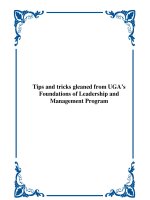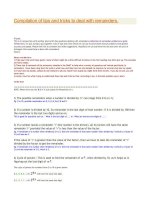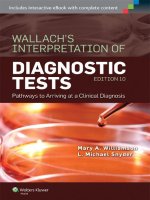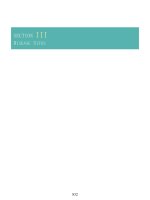Ebook Tips and tricks of bedside cardiology (first edition): Part 1
Bạn đang xem bản rút gọn của tài liệu. Xem và tải ngay bản đầy đủ của tài liệu tại đây (3.2 MB, 130 trang )
TIPS AND TRICKS OF
BEDSIDE CARDIOLOGY
TIPS AND TRICKS OF
BEDSIDE CARDIOLOGY
Atul Luthra MBBS MD DNB
Diplomate
National Board of Medicine
Consultant
Physician and Cardiologist
New Delhi, India
®
JAYPEE BROTHERS MEDICAL PUBLISHERS (P) LTD
New Delhi • St Louis (USA) • Panama City (Panama) • London (UK) • Bengaluru
• Ahmedabad • Chennai • Hyderabad • Kochi • Kolkata • Lucknow • Mumbai • Nagpur
Published by
Jitendar P Vij
Jaypee Brothers Medical Publishers (P) Ltd
Corporate Office
4838/24 Ansari Road, Daryaganj, New Delhi - 110002, India, Phone: +91-11-43574357,
Fax: +91-11-43574314
Registered Office
B-3 EMCA House, 23/23B Ansari Road, Daryaganj, New Delhi - 110 002, India
Phones: +91-11-23272143, +91-11-23272703, +91-11-23282021
+91-11-23245672, Rel: +91-11-32558559, Fax: +91-11-23276490, +91-11-23245683
e-mail: , Website: www.jaypeebrothers.com
Offices in India
•
•
•
•
•
•
•
•
•
Ahmedabad, Phone: Rel: +91-79-32988717, e-mail:
Bengaluru, Phone: Rel: +91-80-32714073, e-mail:
Chennai, Phone: Rel: +91-44-32972089, e-mail:
Hyderabad, Phone: Rel:+91-40-32940929, e-mail:
Kochi, Phone: +91-484-2395740, e-mail:
Kolkata, Phone: +91-33-22276415, e-mail:
Lucknow, Phone: +91-522-3040554, e-mail:
Mumbai, Phone: Rel: +91-22-32926896, e-mail:
Nagpur, Phone: Rel: +91-712-3245220, e-mail:
Overseas Offices
•
North America Office, USA, Ph: 001-636-6279734,
e-mail: ,
•
Central America Office, Panama City, Panama, Ph: 001-507-317-0160,
e-mail:
Website: www.jphmedical.com
•
Europe Office, UK, Ph: +44 (0) 2031708910, e-mail:
Tips and Tricks of Bedside Cardiology
© 2010, Jaypee Brothers Medical Publishers (P) Ltd.
All rights reserved. No part of this publication and CD-ROM should be reproduced, stored in
a retrieval system, or transmitted in any form or by any means: electronic, mechanical,
photocopying, recording, or otherwise, without the prior written permission of the author and
the publisher.
This book has been published in good faith that the material provided by author is original.
Every effort is made to ensure accuracy of material, but the publisher, printer and author
will not be held responsible for any inadvertent error(s). In case of any dispute, all legal
matters are to be settled under Delhi jurisdiction only.
First Edition: 2010
ISBN 978-93-80704-99-9
Typeset at JPBMP typesetting unit
Printed at
To
My Father
Mr PP Luthra
who made me
&
to
My Mother
Ms Prem Luthra
whose fond memories
always guide me
Foreword
With the widespread availability of sophisticated investigative technology,
the clinical approach towards the diagnosis of heart disease has undergone
a paradigm shift. These days, it has become customary to diagnose a cardiac
ailment solely on the basis of an electronic report generated by a CATHlab., ECHO-room or EPS-facility. Nevertheless, a meticulously taken medical
history and a thoroughly performed physical examination have been and
will remain indispensable tools to mentally construct a plausible clinical
diagnosis of heart disease.
The electrocardiogram (ECG), chest skiagram (X-Ray) and
echocardiogram (ECHO) are simple yet informative diagnostic modalities
that have withstood the test of time. They elegantly complement the
information gathered from medical history and physical examination and
they are cost-effective investigations in resource sensitive settings. Moreover,
since the equipment for these tests are portable, the tests can be conveniently
performed at the patient’s bedside and the results interpreted in the light of
clinical data.
I must compliment Dr Luthra for this brilliant and unique title Tips and
Tricks of Bedside Cardiology. He has elegantly compiled a wide variety of
real-world clinical situations encountered during the course of cardiology
practice. The discussion and clinical pearls after each case description are
really worth appreciating. Cardiology students preparing for their
examinations, resident doctors and paramedical staff working in cardiaccare units as well as non-cardiologist physicians dealing with heart patients
are most likely to benefit from this book.
I wish Atul and his excellent book all success.
Dr JPS Sawhney
Chief of Clinical Cardiology
Chairman, Department of Cardiology
Sir Ganga Ram Hospital
New Delhi, India
www.preventivecardiology.in
Preface
There was a time when heart disease was diagnosed at the bedside of the
patient. Clinicians were like detectives who would skillfully gather vital
diagnostic clues from a thoughtfully taken medical history and a
meticulously performed clinical examination. Present-day cardiology is
replete with a wide variety of high-tech diagnostic tools that seem to have
eclipsed the art of making a clinical diagnosis. In this scenario, it would be
worthwhile to amalgamate the conventional with the contemporary as in
several other aspects of life in general and the field of clinical medicine in
particular.
It gives me immense pleasure to present Tips and Tricks of Bedside
Cardiology, a harmonious blend of the time-honored clinical approach with
the modern technical approach, towards the diagnosis of heart disease. The
book is formatted as clinical cases, giving the reader an opportunity to
mentally construct a plausible diagnosis from symptoms and signs.
Illustrations of electrocardiograms, chest radiographs and echocardiograms
that follow, aid in clinching the diagnosis. Each case description is followed
by a discussion which incorporates the differential diagnosis in that
particular patient. The clinical pearls given at the end provide the key
‘take-home’ messages.
It has been my endeavor to incorporate most cardiac diseases
encountered in heart-clinics and ward-rounds but there may be some
omissions. While avoiding case duplication to the extent possible, some
clinically important facts may have been emphasized repeatedly. I sincerely
hope that the wealth of clinical material presented in a concise, readable
and assimilable form will rekindle the romance between the clinician and
clinical cardiology. These tips and tricks should benefit students undergoing
training in cardiology and preparing for examinations as much as they
would interest clinicians involved in the care of heart patients.
Atul Luthra
www.atulluthra.in
Acknowledgments
I am extremely grateful to:
• My school teachers who helped me to acquire command over spoken and
written English language.
• My professors at medical college who taught me the science and art of
clinical medicine.
• My heart patients whose clinical examination and investigation results
stimulated my grey matter and made me wiser.
• Authors of books on ECG, ECHO and X-ray to which I referred liberally
while writing the manuscript.
• M/s Jaypee Brothers Medical Publishers (P) Ltd who felt confident to
assign this project to me and provided expert editorial assistance at all
stages of publication.
• My wife Arti and daughters Ankita and Aastha who left me to myself
while preparing and finalizing the manuscript of the book.
Contents
1. Systemic Hypertension, Headache and Dizziness ......................... 1
2. Exertional Angina & Fainting Episodes ........................................... 5
3. Young Hypertensive, Exertional Fatigue ......................................... 9
4. Thin and Tall Male & Early Diastolic Murmur ............................. 13
5. Severe Chest Pain, Cold & Blue Hand ............................................ 17
6. Sudden Chest Pain & Continuous Murmur ................................... 21
7. Palpitation and Dyspnea, Mid-diastolic Murmur ........................ 25
8. Dynamic Precordium & Pansystolic Murmur ............................... 29
9. Episodic Palpitation & Vague Chest Discomfort ........................... 33
10. Exertional Fatigue & Syncopal Episodes ....................................... 37
11. Exertional Dyspnea, Stiff Back and Red Eye .................................. 41
12. Sudden Breathlessness & New Systolic Murmur .......................... 45
13. Strong Collapsing Pulse & Early Diastolic Murmur ..................... 49
14. Anemia, Dyspnea & Soft Systolic Murmur .................................... 53
15. Incidentally Detected Pansystolic Murmur .................................... 57
16. Strong Bounding Pulse & Systolo-diastolic Murmur .................... 61
17. Squatting Attacks, Blue Lips & Tips ............................................... 65
18. Raised, Jerky JVP & Pansystolic Murmur ....................................... 69
19. Prominent ‘a’ Wave & Ejection Systolic Murmur ........................ 73
20. Flu-like Syndrome, Fatigue & Orthopnea ....................................... 77
21. High Fever, Joint Pains, Sore Throat & Skin Rash ....................... 81
22. Weak Pulse & Basilar Rales ............................................................ 85
(xiv) Tips and Tricks of Bedside Cardiology
23. Raised JVP & No Murmur ................................................................ 89
24. Angina, Syncope & Double Apex Beat ........................................... 93
25. Low Fever with Bodyache & Chest Pain on Inspiration ............... 97
26. Low BP, Raised JVP & Silent Precordium ..................................... 101
27. Raised JVP, Edema & Distended Abdomen ................................. 105
28. Productive Cough, Dyspnea & Wheeze ....................................... 109
29. Chest Pain & Dyspnea after Air Travel ........................................ 113
30. Exertional Dyspnea, Cyanosis and Fainting ............................... 117
31. Fever with Chills & Petechial Spots .............................................. 121
32. Fever with Chills & Illicit Drug Abuse .......................................... 125
33. Constitutional Symptoms & Sudden Hand Cyanosis ................ 129
34. Exertional Dyspnea & Sudden Hemiparesis ............................... 133
35. Displaced & Diffuse Apical Impulse ........................................... 137
36. Retrosternal Discomfort upon Climbing Stairs ........................... 141
37. Recent Increase in Angina Frequency ........................................... 145
38. Severe Chest Pain, Sweating and Sinking .................................... 149
39. Myocardial Infarction & New Murmur on Day 5 ........................ 153
40. Myocardial Infarction & Sudden Worsening on Day 3 .............. 157
41. Low BP and High JVP after Acute Infarction ............................... 161
42. Precordial Bulge after Myocardial Infarction ............................... 165
43. Chronic Effort Angina & Recent Heart Failure ............................ 169
44. Treated Hypertension & Weakness in Both Arms ...................... 173
45. T2DM-HTN-ESRD & Abnormal ECG ........................................... 177
46. LV Dysfunction & Multifocal VPCs .............................................. 181
47. LV Dysfunction & Inducible VT .................................................... 185
48. Episodic “Machine-like”Fluttering in the Chest ......................... 189
49. Palpitation, Weight-loss and Thyromegaly ................................. 193
50. ASMI-STK-CCU & Sudden ECG Change ..................................... 197
51. Palpitation & Abrupt Symptom Termination ............................. 201
52. Systemic Hypertension, Dizziness & Confusion ......................... 205
53. Athletic Youth & Alarming ECG ................................................... 209
54. Healthy Man & Unique ECG ........................................................ 213
Index .................................................................................................. 217
1
Case
Systemic Hypertension,
Headache and Dizziness
Patient Profile
Age: 56
Sex: Male
Built: Obese
Chief Complaints
• Frequent headaches and dizzy spells with blurring of vision.
• Easy fatigability and breathlessness on mild physical exertion.
Relevant History
• The patient was diagnosed to have systemic hypertension at the age of
28 years. At that time, he was investigated for possible secondary hypertension but no abnormality was detected on detailed renal and endocrine
investigations.
• He was prescribed some antihypertensive medicines, but did not take
them regularly and was not on periodic medical follow-up.
• Patient had always been overweight and detected to be a diabetic about
10 years back. He had not got his lipid profile checked recently.
• He smoked 8 to 10 cigarettes per day and consumed 2 to 3 pegs of
whiskey on most days of the week.
Physical Examination
•
•
•
•
Pulse: 84, BP: 160/100, Temp.: 98.2, Resp.: 22
Pulse: regular, good volume, bounding in character
JVP: normal, Thyroid: not palpable, Edema: nil
CVS: Apex beat sustained heaving in nature
Systolic pulsations seen in the aortic area.
S1 normal, S2 normally split, A2 loud, S4 heard
Gr II /VI soft systolic murmur in the aortic area
• Chest: normal breath sounds, no rhonchi or crepts.
An ECG was obtained.
2
Tips and Tricks of Bedside Cardiology
ECG Findings:
• Tall R waves in leads V5, V6
• Deep S waves in leads V1, V2.
An ECHO was also performed.
ECHO Findings:
• Thick septum and LV posterior wall
• Small size of left ventricular cavity.
Systemic Hypertension, Headache and Dizziness
3
Diagnosis
HYPERTENSIVE HEART DISEASE
Discussion
Indications for Echo in Hypertension are:
• Detection of left ventricular hypertrophy (LVH)
• Assessment of LV systolic and diastolic dysfunction
• Detection of coexisting coronary artery disease
• Detection of mitral and aortic valve degeneration
• Detection of aortic dilatation or coarctation of aorta
Echo features of LV Hypertrophy are:
• Thickening of the interventricular septum (IVS) and left ventricular
posterior wall (LVPW). The thickness of septum and free wall exceeds
12 mm (normal 6 to 11 mm).
• Small left ventricular cavity size. Thickening of the IVS and LVPW leads
to obliteration of the LV cavity in systole. Thick papillary muscles with
prominent trabeculae carnae are seen parallel to the LV posterior wall.
• The echo picture of LVH due to hypertension is simulated by LVH due
to other conditions causing LV pressure overload such as aortic valve
stenosis and coarctation of aorta.
• LVH may be indicated on the ECG by presence of tall QRS complexes.
The voltage criteria of S in V1 / V2 plus R in V5 / V6 greater than 35 mm
(Sokolow criteria) is often used. There may be an associated ‘strain
pattern’ with ST segment depression and T wave inversion in the lateral
leads.
4
Tips and Tricks of Bedside Cardiology
Clinical Pearls
• Presence of LVH is the most common abnormality on echo in a
hypertensive patient. Systemic hypertension is also the most important
cause of LVH. Echo cardiography is 5 to 10 times more sensitive than
ECG at detecting LVH.
• LVH is an independent predictor of cardiovascular morbidity and
mortality as a risk factor for myocardial infarction, heart failure and
sudden cardiac death.
• The apex beat is displaced downwards and outwards, is sustained in
entire diastole and heaving in nature. It indicates the presence of LVH
and is also observed in aortic valve stenosis and coarctation of aorta.
• A loud aortic component (A2) of the second heard sound (S2) is a reliable
indicator of systemic hypertension. In aortic stenosis, the A2 is muffled.
An audible S4 in presystole indicates atrial contraction against a noncompliant and hypertrophied left ventricle.
• Prominent systolic pulsations felt along with a soft systolic murmur
heard in the second right intercostal space adjacent to the sternum (aortic
area) indicate dilatation of the proximal aortic root.
2
Case
Exertional Angina &
Fainting Episodes
Patient Profile
Age: 72
Sex: Male
Built: Average
Chief Complaints
• Retrosternal discomfort on climbing stairs, since 2 months.
• Orthostatic dizziness on standing up from sitting position.
• Episodes of light-headedness and fainting after exertion.
Relevant History
• Patient had been a hypertensive and diabetic for several years, fairly
well-controlled on regular medication.
• His present symptoms had appeared about 2 months back and hindered
his daily activities even within the house.
• Although he felt tired and fatigued easily, there was no history of
orthopnea or paroxysmal nocturnal dyspnea.
• There was no history of palpitations or skipped beats preceding the
episodes of fainting.
• His daily cardiac medication included isosorbide mononitrate 40 mg.
metoprolol 50 mg, aspirin 75 mg, ramipril 5 mg and atorvastatin 10 mg.
Physical Examination
•
•
•
•
Pulse: 68, BP: 140/76, Temp.: 98.2, Resp.: 20
Pulse: regular, fair volume, normal in character
JVP: normal, Thyroid: not palpable, Edema: nil
CVS: Normal precordium and apex beat location
Systolic pulsations seen in the aortic area
S1 normal, A2 loud, S4 audible in presystole
Gr II /VI soft systolic murmur in aortic area
• Chest: no rhonchi or crepts audible.
An X-RAY was ordered.
6
Tips and Tricks of Bedside Cardiology
X-RAY Findings:
• Enlargement of heart
• Prominent aortic knuckle.
An ECHO was also performed.
ECHO Findings:
A. Calcified aortic valve
B. Calcific mitral annulus.
Exertional Angina & Fainting Episodes
7
Diagnosis
AORTIC VALVE SCLEROSIS
MITRAL ANNULAR CALCIFICATION
Discussion
• Sclerosis of the aortic valve with some degree of aortic stenosis is
frequently observed in elderly subjects. Calcification of the aortic valve
is the hallmark of aortic sclerosis with or without stenosis.
• Whenever angina pectoris is accompanied by syncopal episodes, one
should always consider the possibility of aortic stenosis.Aortic stenosis
per se can cause both angina and syncope. Alternatively, it causes only
syncope while coronary atherosclerosis causes the angina.
• On chest X-ray, cardiac enlargement with left ventricular contour and
aortic root dilatation could also be due to hypertension per se or aortic
valve regurgitation.
• Sclerosis of the aortic valve is sometimes accompanied by calcification
of the mitral valve annulus. There is a localized highly reflective
echodensity in the posterior segment of the mitral valve annulus. The
calcification also involves the base of the posterior mitral leaflet (PML).
8
Tips and Tricks of Bedside Cardiology
Clinical Pearls
• Systolic pulsations visible in the aortic area with an audible systolic
murmur are indicative of dilatation of the aortic root. Such dilatation
occurs due to aortic sclerosis with systolic hypertension or aortic stenosis
with poststenotic dilatation. In aortic sclerosis the A2 sound is loud while
in aortic stenosis the A2 is muffled.
• Whenever angina and syncope occur together, clinical possibilities are:
– aortic valve stenosis with coronary ostial occlusion
– atherosclerotic coronary disease with arrhythmia
– aortic valve stenosis and coronary artery disease.
• Patients who have angina pectoris with mild hypertension rarely have
ECG signs of LV hypertrophy. When LV hypertrophy is evident, one
must search for a cause other than coronary artery disease.
• This patient should undergo cardiac catheterization and coronary
angiography before aortic valve surgery is contemplated, to judge the
status of the coronary arteries. The coronary arteries may be normal
with only ostial stenosis or they may show luminal occlusion by
atherosclerotic plaques.
3
Case
Young Hypertensive,
Exertional Fatigue
Patient Profile
Age: 28
Sex: Male
Built: Average
Chief Complaints
• Easy fatigability on walking and climbing stairs
• Episodic headache, blurring of vision and dizziness.
Relevant History
• Patient was diagnosed to have systemic hypertension at the age of
16 years and had been on antihypertensive medication eversince.
• For the last 6 years, his dyspnea on exertion had increased considerably
and he complained of early fatigue on climbing stairs.
• His episodes of headache and dizziness were related to strenuous
exertion, emotional upset and missing of his medication.
• He denied chest pain, palpitation or syncope. There was no history of
orthopnea or paroxysmal nocturnal dyspnea.
• His current medication included lisinopril 10 mg, amlodipine 5 mg,
metoprolol 50 mg and hydrochlorthiazide 12.5 mg.
Physical Examination
• Comfortable, no tachypnea, orthopnea or distress
• Pulse: 90, BP: 170/100, Temp: 98.6, Resp.: 18
• Pulse: regular, good volume, bounding in nature.
visible carotid pulsations.
reduced volume and delay in femoral pulse.
• Thinner and atrophic legs compared to the arms.
• BP in lower limbs 140/80 (popliteal reading).
• CVS: Apex beat displaced down and out, heaving in nature.
S1 normal, A2 loud, S4 heard.
Gr III/VI systolic murmur to the left of sternum. Same murmur
also heard in interscapular region.
Continuous murmurs heard over both scapulae.
• Chest: clear or auscultation, no rhonchi or crepts.
10
Tips and Tricks of Bedside Cardiology
An ECG was obtained.
ECG Findings:
• Tall R waves in leads V5,V6
• Deep S waves in leads V1, V2.
An ECHO was also performed
from the suprasternal notch.
ECHO Findings:
• Focal narrowing of the aorta
Young Hypertensive, Exertional Fatigue
11
• Shelf-like luminal projection.
Diagnosis
COARCTATION OF AORTA
Discussion
• In aortic coarctation, there is a localized reduction of the aortic arch
diameter. The narrowing is at the juxta-ductal area (near the ductus
arteriosus), proximal to the ligamentum arteriosum in pre-ductal
coarctation and distal to it in post-ductal coarctation. There is poststenotic dilatation of the descending aorta.
• In pseudo-coarctation of the aorta, there is only tucking at the
ligamentum arteriosum without luminal narrowing. In case of
hypoplastic aorta, there is diffuse narrowing of the aortic root lumen.
• The chest X-ray is often pathognomic of aortic coarctation. There is
notching or indentation of the lower surface of the ribs due to large
collateral vessels. The indentation of the aorta at the site of coarctation
along with dilatation on either side of narrowing produces a
characteristic “figure-of-3” sign.
• The narrowing of the aorta is detected from the suprasternal notch.
The aortic arch is more pulsatile proximal to the coarctation than distal
to it. On CW Doppler, there is a high velocity jet directed away from
the transducer.
• Abnormalities associated with coarctation of aorta are:
– VSD and PDA
– Bicuspid aortic valve









